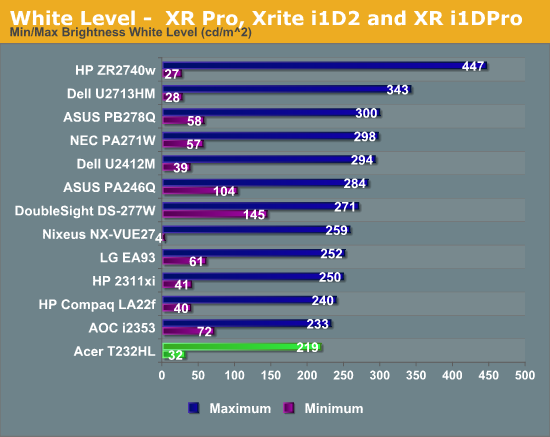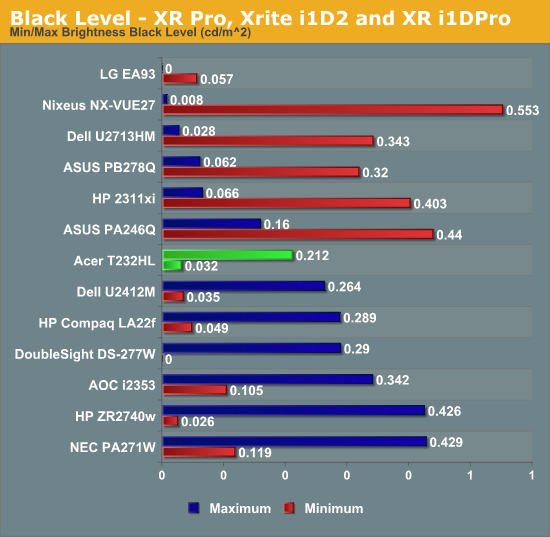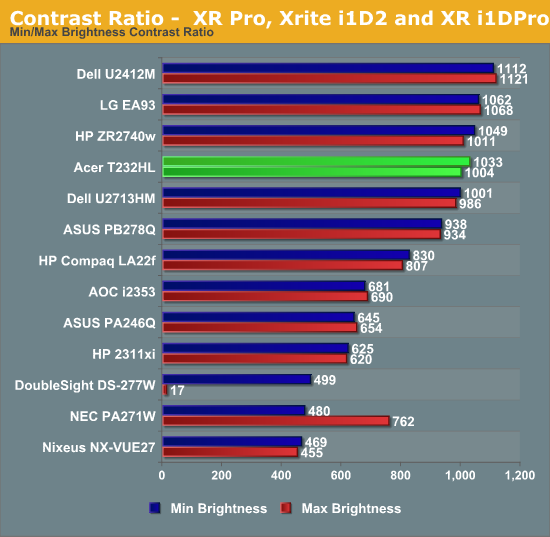Acer T232HL - Touch Comes to the Desktop
by Chris Heinonen on February 6, 2013 9:00 AM ESTBrightness and Contrast
The Acer T232HL uses an IPS panel with LED lighting, so my main curiosity on it was if the touch layer would have a negative impact on brightness and contrast ratios. We’ve seen phones and tablets that maintain very good contrast ratios, but they utilize much smaller screens. With a 23” display I expect to have a good amount of light output, and here the Acer only managed to produce 219 nits with the backlight at maximum. This comes in a bit behind other 23” monitors that I’ve reviewed recently and well behind all the 27” displays that I’ve seen. With the backlight at minimum I managed to get 32 nits out, so you can reduce the light output as much as you would likely want to be able to.

Black level is 0.212 nits with the backlight at maximum and down to 0.032 nits with the backlight at its minimum value. These wind up being really good for a smaller IPS panel, as they typically are a good amount higher. Going back to the touch layer, I’ve no way to test it but if that layer is absorbing 0.1 nits of light, that would lead to almost no change at the white level, but a huge change in the black level.

This small change would make a large change in the contrast levels, and that might account for the contrast levels that I saw in the Acer. Maximum backlight had a contrast of 1033 and minimum had a level of 1004. These are really nice levels and lead to an image with a lot of dynamic punch. The glass front helps to accentuate this a bit as well in comparison to a matte finish, making the Acer really stand out.

I wish the peak brightness on the Acer was better, as 250-300 nits should be the minimum that a monitor can deliver in my opinion. The reflective nature of the glass makes this even more important to me since if you are getting reflections from your lighting, you’ll want to crank the panel backlight up to compensate. If you don’t have glare issues, then the Acer produces contrast numbers that are really nice to see.










66 Comments
View All Comments
JimmiG - Friday, February 8, 2013 - link
"Do you actually think people will sit with a mouse and keyboard in 20 years to the same extent they do today?"No, but I don't think we'll be leaning over our desks, arms stretched forward in order to use oversized touch-displays, nor will we be waving our arms in front of motion sensing devices all day either.
Voice control is another technology that was thought to replace the keyboard ("Keyboard. How quaint."), and the technology exists today. Yet it's rarely used because it's impractical in an office environment.
When realtime 3D graphics became possible, there were a lot of experimental 3D UI's being designed. It was also thought that the whole web would eventually become fully 3D. While we have 3D MMORPG's etc., the web and user interfaces are still 2D because it's the most convenient way to present information. In fact, Windows 8 is even going back to a more "flat" UI than what we've had since the late 1980's.
Just a few examples of how new technology isn't "better" just because it seems exciting and forward thinking at the time. All these technologies have their applications and uses (easily control mixer faders and pan pots in a DAW, for example), but there's a temptation to shoehorn new tech into everything just because it's the current buzzword.
Beaver M. - Friday, February 8, 2013 - link
Why should one think that? But 20 years ago they already hinted that thought-control would be the next big thing. Instead you now see crap like touch-control, which SIMPLY doesnt work well on desktop computers. Touch-control was invented for simple input and mobile input, where you cant have complex inputs.It would be like controlling a kitchen with a steering wheel. It simply isnt effective!
Seriously, it bothers me a lot that even on a site like this, that such simple things isnt grasped by many people.
Patanjali - Friday, April 5, 2013 - link
Touch doesn't have to REPLACE everything else, but it is nice to have as one of many altenate interaction methods. With Windows, you never use ONLY a mouse OR a keyboard, so why should having the availability of touch suddenly preclude those other methods?I find which I use depoends on what I am mainly using at the time. If typing a lot, I tend to use keyboard shortcuts more. If shifting things around a lot, the mouse gets used. Now with touch, I can opt to just reach out and touch a link or swipe to scroll a web page. Horses for couses!
Icehawk - Friday, February 8, 2013 - link
Just saw my friend's Dell version of this (basically) and I don't get it - first off with the screen where it normally goes, and his was, you can't reach the screen without leaning all the way forward and/or hitching yourself forward on the seat. Then you get to leave nice fingerprints everywhere. In that time I could have used the mouse like six times over to do the same thing.And Win 8 looks TERRIBLE. Both the "Metro" skin - too much going on, ugly, ugly, too much clutter - and the old desktop, 'cause no one wants the Start button /sarcasm.
Last thing - while one of my Samsung monitors is going on 7+ years I've had other LCDs last just 2. Would kinda suck if the monitor on one of these goes out since you are pretty much out the whole PC.
ryanbrancel - Friday, February 8, 2013 - link
Do you need to use HDMI for the touchscreen to communicate with the PC? Or does all that transport over the video signal, even for CRT?Lonyo - Saturday, February 9, 2013 - link
USB connection for the touch data.HDMI/VGA/DVI for video.
3.5mm cable for sound when using VGA/DVI (I assume sound can go over HDMI but I haven't tried yet on mine).
Magnus101 - Friday, February 8, 2013 - link
I use a Nexus 7 with TouchDAW installed as a remote control for Cubase.I can move mixer sliders, pots and a lot of things with the tablet, at the same time looking att he big monitors.
I think they have gotten this totally the wrong way around.
It would be awkward to have to have your arms raised so high all the time.
It will also obscure parts of the screen when you point with your hand.
Patanjali - Friday, April 5, 2013 - link
Touchscreen monitors with Windows means that ANY window or dialog can be touch WITHOUT anf setup.Try setting up TouchDAW to control only the Control Room as quickly as just moving the dialog to a touchscreen.
I have Cubase setup with two touchscreens at low angles with the mixers, control room and other dialogs spread across them. And I wish the LG 2560x1080 monitors were touchscreen as they would be perfect for such use.
Patanjali - Friday, April 5, 2013 - link
If you duplicate a local and remote monitor, you can control the dialogs from both.It is a pity the remote display software people that produce MaxiVista and Air Display, which allow using another computer's display, haven't got their Win8 act together.
JKflipflop98 - Saturday, February 9, 2013 - link
LeapMotion is leagues better than this.